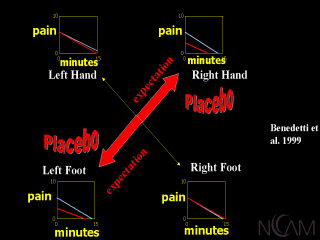| front |1 |2 |3 |4 |5 |6 |7 |8 |9 |10 |11 |12 |13 |14 |15 |16 |17 |18 |19 |20 |21 |22 |23 |24 |25 |26 |27 |28 |29 |30 |review |
 |
Fabricio Benedetti at the University of Turin in Italy took
that experiment one further -- and Iím going to have to walk you through a very complex
experiment here -- that showed that not only does placebo analgesia work through this
endogenous opiate system, but that itís specific for the part of the body. You donít
just release these opiates through the brain, washing the brain, like you would get a shot
of morphine. It affects pain locally. Hereís what he did. He took volunteers, and injected under their skin of all four limbs an extract of the chili pepper, an extract known as capsaicin. Now, for the same reason your mouth burns for several minutes after eating some hot salsa, their skin will burn. It will take several minutes for that pain to diminish. They were told that randomly theyíd be assigned to having a very powerful anesthetic cream applied to that site before the injection on one limb. Not the others. And it turns out that the analgesia was achieved only in that limb, and the analgesic effect could be blocked by this narcotic blocking drug, Naloxone. |